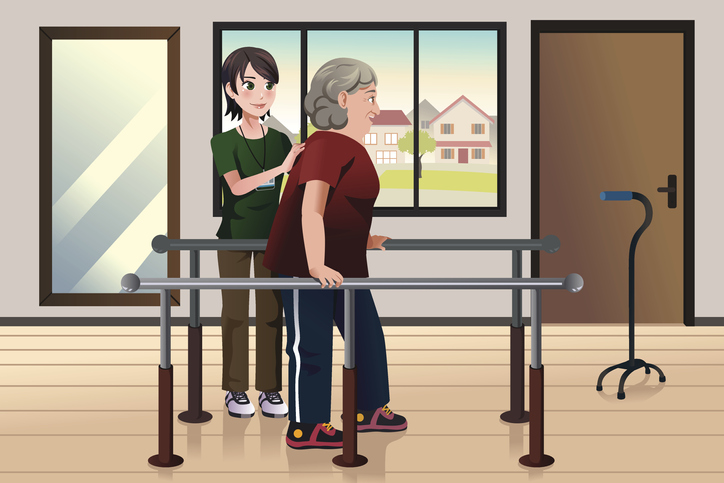Physical Therapy after knee replacement surgery will place you on the road to recovery.
What to Expect from Physical Therapy After Knee Replacement Surgery?
After going through knee replacement surgery, you know that it's time to embark on the road to recovery. Throughout this process, you'll rebuild strength and flexibility, become more confident, and regain mobility.
The best way to recover quickly is to follow the exercises and guidelines of a trained physical therapist. Let's take a look at what to expect.
Physical Therapy Goals
After the surgery, your physical therapist will start to work with you on your recovery goals. The goals will vary from person to person, they'll often include the following:
- Decreasing pain
- Increasing mobility
- Building up muscle strength
- Increasing the range of motion in your joints
- Preventing bad postural habits
Importance of Communicating with your Physical Therapist
A physical therapist is a trained professional whose focus is to support you as you are recovering. They will help you restore and gain ability to move, increase function to help you get back to enjoying life. An important part of treatment planning is to set effective goals. Patient input is key in order to achieve the best outcomes from your physical therapist. Here are tips to keep in mind.
Goals. Talk to your PT about your goals. Is there a favorite activity you'd like to resume? Do you have a time frame in mind for achieving milestones? Maintain communication with your physical therapist so you know what to expect — and they know how to help you.
Follow guidance. The days and weeks following your knee replacement surgery are a pivotal time for rebuilding muscles and regaining mobilization. If you do not follow the recommended exercises, it could impact your recovery and your long-term goals. So, make sure to closely follow your PT's guidance.
Accountability. Make sure that you stay accountable both to your PT and to yourself. You might want to keep a journal on your progress, so that you can have a tangible glimpse at how you're improving day after day.
Home Exercises for Knee Replacement
In addition to working with in a rehabilitation facility or other medical facility, using techniques like soft tissue mobilization, your physical therapist will provide you with exercises to do on your own at every stage of your rehabilitation. Though these will vary slightly from person to person, the American Academy for Orthopedic Surgeons highlights what these exercises will look like:
Post-Op Exercises — After Surgery
In the earliest stages of your recovery, your PT will want to ensure you have good circulation to your legs and feet to prevent the risk of blood clots. An example of an early post-op exercise would be quadriceps sets, where you simply tighten your thigh muscle and hold the contraction before letting go. They also might recommend ankle pumps, where you move your foot up and down for 2 to 3 minutes.
Early Activities — The First Few Weeks
At this early stage in your recovery, your physical therapist will likely recommend that you do the prescribed exercises on average of 20 to 30 minutes a day, 2 or 3 times a day. This may sound like a lot, but this is a very important time in your recovery.
Walking. One of the most important exercises you can do is also the simplest: walk every day. By working yourself up to a comfortable level of walking, you'll be re-training your body to resume its normal activities and strengthen all your muscles.
Stairs. Going up and down stairs will build up your strength and endurance. Remember to take it slow at first, listening to your physical therapist's guidelines and beginning with only a few stairs at a time while holding the rail.
Advanced Exercises
In addition to keeping up with regular walking and ascending (and descending) stairs, your physical therapist will give you more advanced exercises as you improve. One of these might include the standing knee bend, in which you support yourself with your walker and bend your knee upwards, holding for 5 to 10 seconds. Another exercise may include the use an exercycle. An exercycle will support gentle strength-increasing cycling exercises.
Timeline for Recovery
For more than 90% of people, getting total knee replacement surgery is very helpful. Over time, it leads to less pain and greater mobility overall. However, it definitely takes some time — and requires some patience — during the healing process. Although person is different, here's a general timeline you can expect for your rehabilitation:
- First few days.Immediately after the surgery, there will be some post-operative pain. Generally, this is mediated by medications. During this time, you'll probably have your first meeting with a physical therapist.
- First few weeks.After a few days, you will be able to go home or to a skilled nursing facility and begin rehabilitation. You will likely require a walker to get around. A schedule and exercise routine will be prepared, and work will begin with your physical therapist.
- Three to six weeks.Many patients are able to resume many of their daily activities between week three to week six of recovery and rehabilitation. For example, walking up and down stairs and navigating your home. During this time patients who drive may be able to get behind the wheel again.
- Four to six months.Recovery and physical therapy require take for recovery. It may take four to six months to fully recover, though for others it will take more time.
Team Up with your PT for the Best Results
If all goes well, a knee replacement can last for up to 15 years. Although it requires commitment during the rehabilitation process, it will lead you to a life of less pain and greater mobility.
As a long term care and short term physical therapy provider in Georgia, we at Church Home Life Spring understand the recovery process for total knee replacement can be difficult. That's why we provide a caring and supportive rehabilitation facility for those in recovery. Please contact us today if you have any questions.

